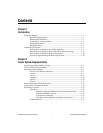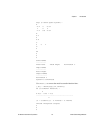
Chapter 1 Introduction
Xmath Control Design Module 1-4 ni.com
Control Design Tutorial
This tutorial illustrates the use of functions and commands provided in
Xmath and the Xmath Control Design Module to solve control problems.
The emphasis of the tutorial is on using a number of different approaches,
not on any one “correct” way to solve a problem. It demonstrates the
flexibility of Xmath’s tools and scripting language to customize your
analysis in a way that is as straightforward and mathematically intuitive as
possible.
The models in this tutorial are adapted from the studies in [ShH92], of the
equations presented in [FPE87], for the longitudinal motion of a helicopter
near hover, and in [HW91], for the inverted-wedge-balancing problem.
Helicopter Hover Problem: An Ad Hoc Approach
[FPE87] gives this state-space model for the longitudinal motion of the
helicopter:
letting the state variables q, θ, and v represent the helicopter’s pitch rate,
pitch angle, and horizontal velocity, respectively. The input control to the
system is the rotor tilt angle, δ.
You can store the information that this model provides in an Xmath
state-space system object:
A = [-0.4,0,-0.01;1,0,0;-1.4,9.8,-0.02];
B = [6.3;0;9.8];
C = [0,0,1];
D = 0;
ssys = system(A,B,C,D,
{inputNames ="Rotor Angle",
outputNames="Horizontal v",
stateNames =["Pitch Rate", "Pitch Angle",
"Horizontal v"]})
q
·
θ
·
v
·
0.4– 00.01–
10 0
1.4– 9.8 0.02–
q
θ
v
6.3
0
9.8
δ+=
y
001
q
θ
v
=


















